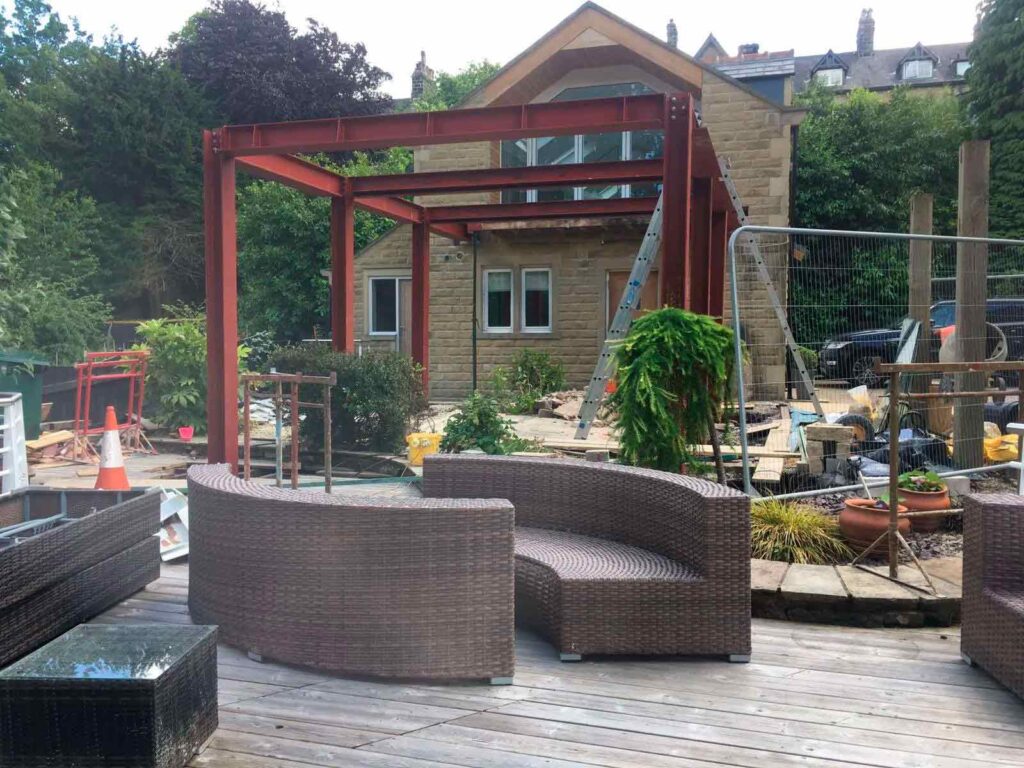You could be putting yourself and others at risk.

A recent steel structure fully fabricated and erected in Ilkley, Leeds by our highly skilled tradesmen. All processed to execution class 2 of the CE standards and fully traceable
CE Marking of products
CE Marking demonstrates compliance with the appropriate manufacturing standard for a product. As a symbol, it will be familiar as it has been a requirement for many years on products sold in the European Union such as toys and electrical goods. Under the Construction Products Regulation (CPR), new legal obligations have been placed on manufacturers, distributors and importers of construction products used within the EU to CE Mark their products where they are covered by either a harmonised standard or European Technical Assessment (ETA). This applies not only to constituent products (such as steel beams, bolts etc) but also to fabricated elements and systems made from CE Marked products.
The CPR requires the CE Marking of all construction products from 1 July 2013 and the CE Marking of fabricated structural steelwork from 1 July 2014. The CPR describes the legal obligations it places on the construction supply chain in terms of ‘manufacturers’, ‘distributors’ and ‘importers’. However, the construction supply chain in the UK would normally be described in terms of clients, designers, specifiers, contractors and specialist subcontractors. The purpose of this document is to provide some guidance to the UK supply chain on the implications of the CPR on steel construction.
CE Marking of fabricated structural steelwork
The harmonised standard covering fabricated structural steelwork is BS EN 1090: Execution of steel structures and aluminium structures. Part 1 of the standard is the Requirements for Conformity Assessment of Structural Components. It describes how manufacturers can demonstrate that the components they produce meet the declared performance characteristics (the structural characteristics which make them fit for their particular use and function). Part 2 is the Technical Requirements for Steel Structures. It specifies the requirements for the execution of steel structures to ensure adequate levels of mechanical resistance and stability, serviceability and durability. It determines the performance characteristics for components that the manufacturer must achieve and declare through the requirements of Part 1.
BS EN 1090-1 becomes mandatory on 1 July 2014. It will therefore be a legal requirement for all fabricated structural steelwork delivered to site from that date to be CE Marked. The BCSA has made CE Marking compliance a condition of membership of the Association from 1 July 2014, so selection of any BCSA Member company will guarantee that the steelwork contractor will have the necessary certification to comply with the CPR requirements. Clients and main contractors will therefore have confidence in the complete supply chain for steel construction from manufacture of the steel sections through distribution to fabrication and erection on site.

ENGINEERS RESPONSIBILITY
For any project, the required quality of fabrication or Execution Class must be specified. BS EN 1090-2 requires the Execution Class to be specified for: • the works as a whole • an individual component • a detail of a component The engineer is responsible for specifying the Execution Class for the structure, the components and the details. In some cases the Execution Class for the structure, the components and the details will be the same while in other cases the Execution Class for the components and the details may be different to that for the whole structure. The procedure for determining the Execution Class is a straightforward four step process: 1. Determine the Consequence Class 2.
Define the Service Category 3. Define the Production Category 4. Derive the Execution Class Whilst each building needs to be considered on its own merits, Execution Class 2 (EXC2) will be appropriate for the majority of buildings constructed in the UK. If the Execution Class is not specified on a project, Clause 4.1.2 of BS EN 1090-2 states that EXC2 shall apply. It should also be noted that the NSSS for Building Construction 5th Edition CE Marking Version has been written for the steelwork contractor to deliver the requirements of EXC2.

An external steel staircase fully fabricated and erected in York by our highly skilled tradesmen. All processed to execution class 2 of the CE standards and fully traceable.











